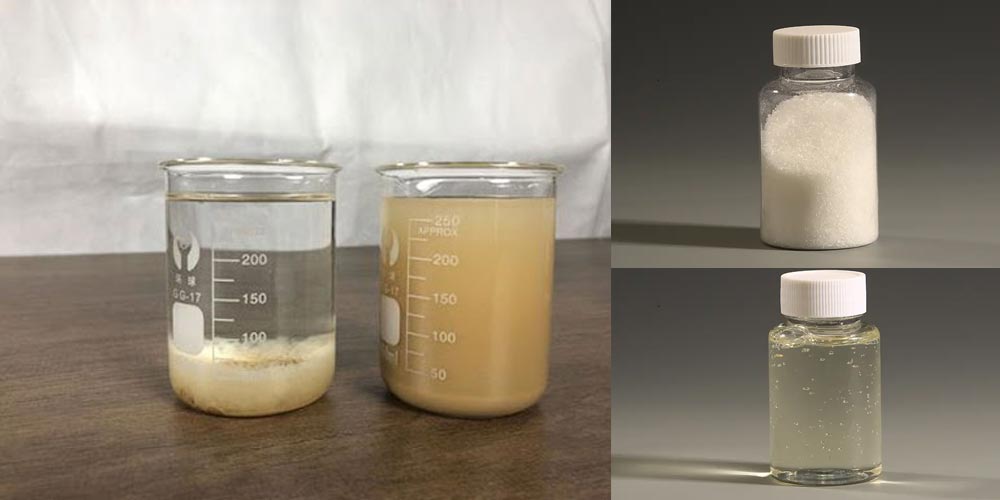Kev kho dej yog ib qho tseem ceeb ntawm kev tswj hwm ib puag ncig, kom ntseeg tau tias cov dej muaj kev nyab xeeb rau kev siv thiab kev lag luam. Ib qho ntawm cov ntsiab lus tseem ceeb hauv cov txheej txheem no yog kev siv flocculants-cov tshuaj uas txhawb kev sib sau ua ke ntawm cov khoom tshem tawm mus rau hauv pawg loj, lossis flocs, uas tuaj yeem yooj yim tshem tawm ntawm dej. Ntawm ntau hom flocculants, cationic flocculants tshwj xeeb tshaj yog zoo vim lawv cov nqi zoo, uas cuam tshuam nrog cov khoom tsis zoo uas feem ntau pom hauv cov dej khib nyiab. Kab lus no tshawb txog cov cationic flocculants feem ntau siv hauv kev kho dej thiab lawv cov kev siv.
Cationic Polyacrylamides(CPAM)
Cationic Polyacrylamides yog ib qho ntawm cov flocculants uas tau siv dav hauv kev lag luam kho dej. Rau ntau tus neeg siv, CPAM yog lawv txoj kev xaiv zoo dua. Cov polymers no muaj cov acrylamide subunits, uas tuaj yeem ua kom haum rau suav nrog cationic functional pawg. Lub versatility ntawm Cationic polyacrylamides nyob rau hauv lawv adjustable molecular hnyav thiab nqi ceev, cia lawv yuav tsum customized rau tej daim ntaub ntawv. C-PAMs muaj txiaj ntsig tshwj xeeb hauv kev kho cov dej khib nyiab hauv kev lag luam thiab sludge dewatering vim lawv cov kev ua haujlwm siab flocculation thiab cov kev xav tau tsawg tsawg.
Poly (diallyldimethylammonium chloride)PolyDADMAC)
PolyDADMAC yog siv dav siv cationic flocculant paub txog nws cov nqi siab ceev thiab kev ua haujlwm zoo hauv cov txheej txheem kho dej. Cov polymer no tshwj xeeb tshaj yog muaj txiaj ntsig zoo hauv cov txheej txheem coagulation thiab flocculation, ua rau nws yog qhov kev xaiv nrov rau kev kho cov dej haus, dej khib nyiab, thiab cov khoom siv hluav taws xob. PolyDADMAC ua haujlwm zoo ua ke nrog lwm cov flocculants thiab coagulants, txhim kho cov txheej txheem kho tag nrho los ntawm kev muab cov txheej txheem zoo rau kev sib sau ua ke thiab tshem tawm.
Polyamines(PA)
Polyamines yog lwm pawg ntawm cationic flocculants feem ntau siv hauv kev kho dej. Cov tebchaw no, uas suav nrog poly (dimethylamine-co-epichlorohydrin) thiab cov qauv zoo sib xws, pom muaj zog cationic nqi ceev, ua rau lawv muaj txiaj ntsig zoo ntawm neutralizing cov khoom tsis zoo. Polyamines muaj txiaj ntsig tshwj xeeb hauv kev qhia meej ntawm cov dej nyoos, tshem tawm cov organic teeb meem, thiab kev kho mob ntawm ntau yam khoom siv hluav taws xob. Lawv lub peev xwm los tsim cov flocs ntom ntom ua rau lub sijhawm daws teeb meem sai dua thiab txhim kho qhov pom tseeb ntawm cov dej kho.
Daim ntawv thov thiab qhov zoo
Cationic flocculants ua lub luag haujlwm tseem ceeb hauv ntau hom kev siv dej kho mob, los ntawm cov dej khib nyiab hauv nroog thiab kev lim dej kom huv mus rau kev tswj xyuas cov dej ntws tawm. Lawv lub ntsiab kom zoo dua yog nyob rau hauv lawv lub peev xwm los ua tau zoo neutralize tsis zoo nqi hais, ua rau kom sai thiab npaum floc tsim. Qhov no ua rau kev txhim kho clarity, txo turbidity, thiab txhim kho tag nrho cov dej zoo. Tsis tas li ntawd, cationic flocculants feem ntau yog siv ua ke nrog lwm cov tshuaj kho mob, xws li coagulants, los txhim kho cov txheej txheem kho thiab ua tiav cov qauv dej zoo.
Kev siv cationic flocculants yog ib qho tseem ceeb rau cov txheej txheem kho dej niaj hnub, muab cov kev daws teeb meem zoo thiab txhim khu kev qha rau kev sib sau ua ke thiab tshem tawm. Polyacrylamides, polyamines, PolyDADMAC sawv cev rau qee qhov feem ntau thiab muaj txiaj ntsig cationic flocculants muaj hnub no. Lawv versatility, efficiency, thiab adaptability ua rau lawv indispensable cuab yeej los xyuas kom meej muaj cov dej huv thiab nyab xeeb rau ntau yam kev siv.
Tau kawg, qhov kev xaiv ntawm flocculant kuj nyob ntawm tus neeg siv tus cwj pwm siv, cov khoom muaj pes tsawg leeg, ib puag ncig, thiab lwm yam. Cov khoom siv qhia yuav tsum ua raws.
Post lub sij hawm: Jun-05-2024


